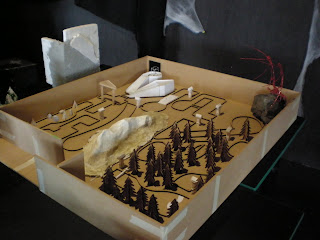
I found this excert from MIND magazine online at http://www.jstor.org/pss/2247778.
Shurman is describing Aristotle's view of Metaphysics and intellegence, which suggest that intellegence and conclusions of 'reality' go hand-in-hand with a subjects modes of thought and sensory evaluation.
The job of an illusion is to fool ones senses into perceiving reality. The believability of an illusion depends on the accuracy of application and the satisfaction of appropriate senses.
Brief History of Pepper's Ghost
Pepper's Ghost Effect has been used since 1816 to create translucent ghost-like characters in theatre scenes. It has been adapted and used by carnivals, theme parks, movie makers, and other sorts of magicians since then.
Below is a scene from "Diamonds are Forever" where they recreate the famous "Girl to Gorilla" freak show attraction. The original illusion depicts an image of a girl (reflected by a glass pane) morphing into the physically present gorilla, by use of lighting fades on the respective characters.It is interesting to note that although a Peppers Ghost illusion is not technically concidered to be a hologram, when well constructed and thought out, "You can easily convince the general pulic that you're using holograms"[1].
Making a Pepper's Ghost
When creating a Peppers Ghost style hologram there are many important factors to concider so that the audience is intrigued and taken in by the illusion.
Considerations of character, environment/setting, lighting, interaction, sensory requirements and other practical elements, such as focal length, determine the effectiveness of the outcome.
In short the audience should percieve a holographic character which resides in physical space. It needs to be believable to a point where the audiences' disbelief is suspended and they invest in the hypothetical premise of the narrative.
Focal length
An important concept for creating a character which resides believably in the physical scene, at the right depth, is to have the projected image (light) at a similar distance from the reflective screen (glass pane) as the location it is to appear to occupy in viewed physical space.
In this small mock up I have used two panes of glass and two iterations of the same character (near and far) so that the character appears to reside near the trees in the physical scene (in the further pane) then flash forwards to the viewer in the closer pane. When viewing this illusion in the apparatus directly, the audiences eyes converge at different focal lengths for each pane. This helps to satisfy occulomotor depth cues [2], which helps to subdue disbelief further.
Mannequin (3D Prop) or Light Projector?
There are pro's and con's for each of these methods. When using a traditional prop it can be hard to mechanise the character in a way that depicts natural movement. However, because you are projecting light onto a three dimensional object this can satisfy some linear parallax issues. The light projector method draws its strength mainly from the versatility of what you can project/depict and the sort of movement you can endow your characters with. ...Ultimately, this is a decision you must play around with to see what will work best for you.
Relation to the environment
Size of the character is important. If you have a human character who is as big as a house in your physical scene then this may interfere with believability of the narrative.
Also, you must make sure to choose the right aesthetic qualities for your subject and environment so that they match the theme of your intended narrative. Eg. I dont think Vlad the Impaler would be a beliveable character if he was wearing pink Chuck Taylors and a Slayer Tshirt whilst wandering the halls of his castle. ....Intriguing perhaps.??
Audio sensory
Having matching audio tracking with your hologram will help your audience further believe in your scene. This is an important element as humans generally percieve thier reality, not via visual input alone, but by a mix of sensory stimulis and evaluative thought.
Speaker systems (etc) should be placed so that the audience percieves the sound to be coming from the character.
Interaction
By timing a looped scene to coincide with audience arrival, or triggering it as new subjects enter, can add to the illusion of reality by suggesting interaction between audience and characters. I can see great scope for the use of motion/colour tracking and real time video conversion and display, to be integrated with this illusion to heighten the immersive experience for the viewer.
Other practical concerns
- When using an LCD projector you will have to buy new lamp bulbs fairly often (depending on how often it is running).
- image space and set probably have to be separated from viewing area for safety and to avoid tampering from sneaky hands.
- Acrylic is a good substatute for glass for safety, but is prone to bend and buckle when not supported correctly. This will distort your image.
- Amount of light projected, and the scattering thereof [2], will determine how translucent your character appears to the viewer and will enhance some of the depth cues for your projected 3D character.
Conclusion
This is an effect which has played an important, yet somewhat illusive role in pop culture history and entertainment. The advent of new technologies which can be integrated to enhance this illusion leave plenty of scope for it to be used and adapted in the future as we ride the wave of new technologic thought and technological expansion.
References
[1] http://www.phantasmechanics.com/pepper.html [2]An Introduction to Computer Graphics and Creative 3D Environments. B. G Blundell, 2008. [3] http://www.doombuggies.com/secrets_ballroom.php [4] http://www.sciencedaily.com/releases/2007/04/070411170904.htm “Wired For Sound: How The Brain Senses Visual Illusions”[5] http://www.cfar.umd.edu/~fer/optical/ “Optical Illusions”. [6]PSYCHOLOGICAL REVIEW Mind.1898; VII: 441-442






